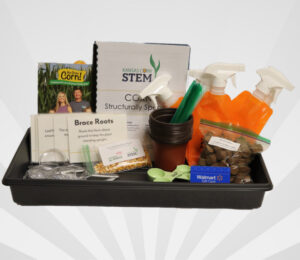Free Classroom Kit
Corn: Structurally Speaking
Grade Level: 4th Grade
 This unit, which focuses on plant structures and functions, is spread over several weeks in order to grow corn plants in the classroom to be used in the last lesson. In the first lesson, students plant corn seeds in order to sprout plants to be used three weeks later. They also set up their science notebooks to record ongoing observations. In the second lesson, which involves observations over 3-5 days, students investigate how a seed germinates, with the structures and functions of seeds being emphasized. The third lesson culminates in students observing and drawing a full corn plant, identifying structures and functions of the plant. These lessons can be modified so that instead of growing the plants in the classroom, full corn stalks are brought into the classroom for the final lesson.
This unit, which focuses on plant structures and functions, is spread over several weeks in order to grow corn plants in the classroom to be used in the last lesson. In the first lesson, students plant corn seeds in order to sprout plants to be used three weeks later. They also set up their science notebooks to record ongoing observations. In the second lesson, which involves observations over 3-5 days, students investigate how a seed germinates, with the structures and functions of seeds being emphasized. The third lesson culminates in students observing and drawing a full corn plant, identifying structures and functions of the plant. These lessons can be modified so that instead of growing the plants in the classroom, full corn stalks are brought into the classroom for the final lesson.
Quick Links
About Kansas Corn STEM
Investing in Kansas teachers and students is a priority for the Kansas Corn Commission. We are committed to providing materials and training to support STEM education while fostering an understanding of how corn farming and agriculture fit into our daily lives. All K-5 lessons come with a free teacher kit that includes the teaching materials needed for each lesson.
Request MaterialsThis lesson is the work product of the Kansas Corn Commission. Our lessons are written in collaboration with Kansas teachers for use in the classroom. Teachers may copy and share this curriculum. Use of this product for commercial or promotional use is prohibited without express permission of Kansas Corn.
Newsletter Sign Up
Each quarter we release a newsletter written by teachers for teachers. This is an easy way to keep up with what is happening at Kansas Corn STEM.
Subscribe Today!